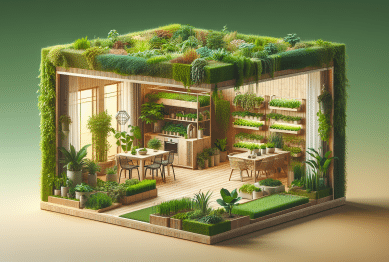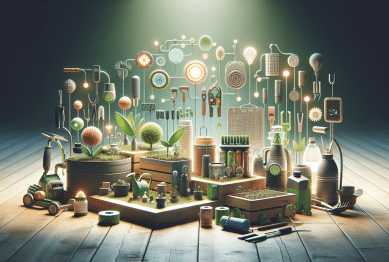Discover how rainwater harvesting can make a real difference for your home garden and water bill. Uncover practical methods, understand simple setups, and see why many gardeners say this approach has revolutionized their outdoor spaces.
Why Rainwater Harvesting Is Gaining Popularity
Many homeowners are exploring ways to reduce dependency on municipal water and support their gardens sustainably. Rainwater harvesting is a technique growing in demand due to mounting concerns about drought, increased water bills, and garden sustainability. Unlike tap water, harvested rainwater contains no chlorine or harsh additives, making it ideal for nourishing plants. With environmental pressures mounting, more gardeners are adopting simple collection systems for their yards.
Rainwater harvesting isn’t just popular because of environmental reasons. There’s a real cost-saving element too, especially for households with extensive lawns or vegetable patches. Using rain barrels or larger cisterns to collect runoff from roofs can yield hundreds of gallons per rainfall, significantly cutting monthly water costs. Communities that encourage rain harvesting often experience reduced pressure on local water infrastructure as well.
Enthusiasm for the practice continues to rise as people see tangible results. Some report lusher gardens, fewer drought-stressed plants, and a heightened sense of stewardship over natural resources. Plus, installing a simple system does not require advanced plumbing knowledge. Even basic setups provide a meaningful supplement to traditional watering routines, empowering anyone to take part in eco-friendly gardening practices.
Gathering Rainwater: Methods and Setups
There are several approaches to rainwater harvesting that fit different property sizes and budgets. The simplest involves rain barrels, which are placed under downspouts to collect water from rooftops. These barrels typically include screens to keep debris out and spigots for easy access. Some gardeners link multiple barrels to increase capacity, especially in regions that see periodic heavy rainfall.
Larger properties sometimes invest in above-ground tanks or below-ground cisterns. These store significant amounts of water, suitable for both ornamental gardens and food crops. Advanced setups might add filtration or first-flush diverters, which divert initial runoff to remove contaminants. Homeowners often prioritize these extra features when water is used for larger-scale irrigation or for non-potable indoor purposes such as flushing toilets or washing cars.
The method chosen often depends on space, rainfall volume, and how the harvested water will be used. Some prefer compact barrel systems for patio gardens. Others choose full-scale systems to irrigate lawns or edible gardens throughout the growing season. Installation can be do-it-yourself for small units, while professional help may be sought for complex cisterns. A little planning yields a custom approach suited to a variety of garden sizes and needs.
Benefits for Your Garden and Environment
Rainwater harvesting provides clear benefits for soil and plant health. Natural rainwater is soft and free from salts and chemicals, unlike some well or city water supplies. Plants absorb this water readily, showing improved foliage and less leaf scorching. Soil microbes also thrive under regular applications of rainwater, contributing to better nutrient cycling and root growth.
Another benefit is reducing stormwater runoff. When heavy rain falls, water rushes off roofs and hard surfaces, flowing directly into storm drains and local water bodies. This can carry fertilizers, pesticides, and pollutants with it, harming urban streams and rivers. Harvesting rainwater slows the flow, helps groundwater recharge, and acts as a small-scale buffer against urban flooding.
On a larger scale, rainwater harvesting supports water conservation efforts, especially in areas prone to drought or with restricted municipal supplies. Even modest systems installed on private properties can make a collective difference, mitigating the burden on infrastructure and enhancing local ecosystem health. Some cities and neighborhoods offer incentives, discounts, or even rebates to encourage these practices, multiplying their positive impact.
Setting Up a System: What You Need to Know
Setting up your first rainwater harvesting system is straightforward, though a few factors should be considered. Start by estimating how much water your garden needs and how much rain your roof collects. Online calculators or local extension offices often provide helpful tools for these estimations. Consider roof material, as some may leach contaminants if not suited for potable or irrigation uses.
For a typical home, a single 55-gallon barrel may suffice for container gardens or small beds. Larger gardens benefit from multiple barrels or bigger tanks, linked in series. Always use a screened intake to block leaves and insects, and check regional regulations, as some areas have rules on catchment size or overflow management. Maintenance is minimal—occasional cleaning and ensuring outlets aren’t clogged will keep things running smoothly.
Placement matters. Barrels or tanks should stand on level, stable surfaces near downspouts for efficient fill-up. Consider overflow strategies to direct excess water away from foundations into landscape beds or permeable areas. Accessories like watering can adapters, hoses, or drip systems enhance convenience, letting you distribute water where it’s needed most. Most importantly, keep safety in mind, ensuring containers are secure and child- or animal-proof.
Legal and Practical Considerations for Homeowners
Not every region allows unrestricted rainwater capture. Some places set limits on storage size, require particular barrel types, or have rules for overflow drainage. Always check local ordinances before installing a system to avoid conflicts or fines. Many states and provinces provide practical guides or offer incentives for sustainable water use, but details vary widely.
Incentive programs may include rebates for equipment, free barrels, or technical assistance with installation. These are often coordinated by city or county water agencies keen to reduce overall demand on their systems. Some regions with limited rainfall or fragile aquifers actively promote rainwater harvesting as part of a broader sustainability push, featuring education campaigns or demonstration gardens to show residents what’s possible.
Safeguarding water quality should be a priority. Use food-grade barrels, avoid collecting from treated wood or roofs with heavy metals, and always keep containers covered to prevent mosquito breeding. Practice regular inspections. By following these reasonable precautions, gardeners ensure their system delivers clean water—and peace of mind—throughout the season.
Maximizing the Value of Your Harvested Water
Collected rainwater is ideal for landscape use, including ornamental beds, vegetable plots, container gardens, and young trees. Drip irrigation and soaker hoses allow efficient water distribution, minimizing evaporation and runoff. In times of drought or watering restrictions, having your own reserve can keep gardens thriving.
Water harvested in this way can also serve non-garden functions. Some homeowners use it for cleaning tools, filling birdbaths, or washing pets. Others deploy their reserves for flushing outdoor toilets or cleaning patios. With the right setup, even small rain events provide a surprising bounty to be used in creative and resourceful ways.
Maximizing value also means ongoing engagement. Monitor rainfall, system performance, and water use patterns. Adapt your setup seasonally or as your gardening needs change. Over time, many find that rainwater harvesting becomes a central—and rewarding—part of their home and garden routines, reinforcing a deeper relationship with natural cycles.
References
1. Environmental Protection Agency. (n.d.). Rainwater Harvesting. Retrieved from https://www.epa.gov/soakuptherain/soak-rain-rain-barrels
2. Texas A&M AgriLife Extension. (n.d.). Rainwater Harvesting. Retrieved from https://rainwaterharvesting.tamu.edu/
3. United States Geological Survey. (n.d.). Water Science School: Rainwater Harvesting. Retrieved from https://www.usgs.gov/special-topics/water-science-school/science/rainwater-harvesting
4. National Gardening Association. (n.d.). Rain Barrels for Beginners. Retrieved from https://garden.org/learn/articles/view/2361/
5. University of California Agriculture and Natural Resources. (n.d.). Rainwater Harvesting for Homeowners. Retrieved from http://cesonoma.ucanr.edu/Water_Resources/Rainwater_Harvesting/
6. American Rivers. (n.d.). Water Conservation: Rain Barrels. Retrieved from https://www.americanrivers.org/threats-solutions/clean-water/rain-barrels/









